Mashiko Potter In Minnesota
From Minnesota to Mashiko and Back.
Sunday, March 7, 2021
Saturday, January 9, 2021
Ox And The Big Dipper
I showed this image to Warren. He laughed and he told me a story:

He an Alix went out for a Sunday ride on their motorcycle while they were working with Leach at St. Ives. They stopped at a shop and saw the Charger above. It was just taken out and put on a shelf. Made by Hamada while he was at St. Ives. Warren said the foot was jagged because the Galena ran off the pot and stuck to the kiln shelf.
They were excited, but didn't have any money with them. They rode the motorcycle back to the pottery and told Bernard about the pot. Bernard remembered it and loaned them the money to buy it. They hurried back and someone else bought it while they were gone. Warren said to me, "I don't know why on earth we didn't ask to have it held for us."
Friday, March 10, 2017

Warren Mackenzie: Bridging St. Ives and Mashiko (this is a work in progress.)
Warren Mackenzie’s first exposure to Japan was when he was station there after WWII, during the American occupation. Mackenzie was in a unit responsible for maps and printing. Because the Japanese print shop did most of the actual printing for them, their commander told them to paint images of Japan to keep them busy. Below is a water color of a Shinto Shrine Mackenzie painted.


His first experience of Mingei was when he purchased a Shiko Munakata woodblock print while stationed in Japan. He had no idea he would later be immersed in Mingei’s creative philosophy as a potter in St. Ives, England.
When Mackenzie returned to America and registered at the Chicago Art Institute, where he studied before getting drafted into the Army, all the painting classes were filled and the only class that was open was a pottery class. That is where he met his first wife Alix. Their instructor turned out not to know anything about pottery, but they found Bernard Leach’s book, A Potter’s Book and took up self instruction. They quickly realized they needed serious instruction and decided to go to England to ask Bernard Leach to take them as apprentices.

Warren and the late Alix Mackenzie traveled to St. Ives and apprenticed with him for over 2 years. Not only that, they lived with him in his house and found the discussions about pottery and mingei to be the most rewarding aspect of their stay in St. Ives.
At the end of their apprenticeship in 1952, before they left for America there was the International Potters and Weavers Conference at Dartington hall. Leach invited Shoji Hamada and Yanagi to attend and that is where the Mackenzies met Hamada and Yanagi. It was Hamada’s first trip back to England since 1935.
Mackenzie has always said, though he apprenticed with Leach, Shoji Hamada has always been his main creative inspiration.

Leach decided to go back with Hamada and Yanagi, but instead of going East, back the way they came by ship, they would fly across the atlantic and then travel by ground across the USA.
Alix Mackenzie approached them and said, “Look, if you’re going to travel through America, why not do a series of workshops while you’re crossing America?” So Hamada thought for a while, said, “All right.” He said, “If you will arrange it, we’ll do it.” It was arranged to stop at St. Paul where the Mackenzies taught. And also Black Mountain College in North Carolina where Marguerite Wildenhain was and the Archie Bray Foundation in Helena, Montana with Rudi Autio, and Peter Voulkos, and in California at the Chouinard Institute, where Susan Peterson was teaching.
Alix Mackenzie also arranged a show for Hamada. Shinsaku Hamada sent the pots from Mashiko. It also included 20 pots by Kanjiro Kawaii. Hamada and Kawaii first showed at a major museum in America in St. Paul.

During Hamada’s visit to St. Ives Pottery, Mackenzie was able to walk behind Leach and Hamada and Hamada surveyed what was currently being made at the pottery. He did this quietly, with Leach beside him. Finally, Leach asked Hamada what he thought. At the time, the pottery was making catalog ware. Stoneware that was made identical to a catalog that was used to market them. Not the Lead glazed slipware that both Yanagi and Hamada like the most of what Leach made. Finally, Hamada said to Leach, “The best thing that could happen to this pottery is if it would burn down.”
An amusing thing happened after Yanagi, Leach and Hamada visited Black Mountain College. After the workshop there, Marguerite Wildenhain told her students, “I want you to forget everything you just saw.” She was train in Bauhaus in Europe and did not see merit in the Mingei Philosophy the trio shared. Maybe because it went in the opposite direction of her modernist perspective she worked at next to Paul Klee and Wassily Kandinsky.

While Mackenzie laid the foundation for mingei inspiration in Minnesota and Wisconsin, the tour he and Alix arranged in the ‘50s across the United States also influenced important people like Wildenhain, Voulkos and Peterson.
Mackenzie is 93 years old and continues to work in his studio,

making functional pots every day. He is one of the most influential functional potters alive in the United States today. His friendship with the late Tatsuzo Shimaoka facilitated many Midwestern students coming to Mashiko to study at Shimaoka’s pottery. Mackenzie cultivated an appreciation for Mashiko ceramics in the West, through his work, teaching and the work and teaching of his students.
Thursday, January 21, 2016
MacKenzie, Shimaoka, Hamada and a "Bunchong" Dish.
MacKenzie, Shimaoka, Hamada and a "Bunchong" Dish.
Saturday, at his Pots In The Grass sale. I had the opportunity to remind Warren of an event from about 12 years ago in Mashiko, Japan. I said to Warren, "You might not remember it. I do, because when I got home, I wrote it down."
 Tatsuzo Shimaoka and Warren MacKenzie Warren and Nancy MacKenzie visited Mashiko in 2002, in the middle of my 3 year apprenticeship with National Living Treasure, Tatsuzo Shimaoka. Warren was visiting during the opening of Soetsu Yanagi's house across the street from the Mingei Museum, which celebrated with a show of MacKenzie's, David Leach's, Sori Yanagi and Shimaoka's work in the Yanagi House.
Tatsuzo Shimaoka and Warren MacKenzie Warren and Nancy MacKenzie visited Mashiko in 2002, in the middle of my 3 year apprenticeship with National Living Treasure, Tatsuzo Shimaoka. Warren was visiting during the opening of Soetsu Yanagi's house across the street from the Mingei Museum, which celebrated with a show of MacKenzie's, David Leach's, Sori Yanagi and Shimaoka's work in the Yanagi House. Korean Buncheong Dish in Hamada MuseumOne of the things I had the good fortune to do, was follow Shimaoka and Warren, as Shimaoka gave Warren a tour of the Hamada Museum. (Warren nodded in appreciation when I mentioned this. He did remember the tour.) I heard details about the many objects there that you wouldn't know about, just walking through the museum by yourself. When we got to this Korean Choson Buncheong dish behind the glass (pictured at the right), Shimaoka stopped and said to MacKenzie: "I have a dish just like this. Many years ago, while Hamada was alive, I had him come see the dish. When I unpacked it, Hamada smiled and said to me:'I have a dish just like this, but an expert told me it is a fake.'"After a pause, Hamada told Shimaoka, "But I don't care.... Because I cannot tell the difference." This point struck home with me. For the creative person, collecting isn't a part of acquisitiveness. It is about the maker's education.
Korean Buncheong Dish in Hamada MuseumOne of the things I had the good fortune to do, was follow Shimaoka and Warren, as Shimaoka gave Warren a tour of the Hamada Museum. (Warren nodded in appreciation when I mentioned this. He did remember the tour.) I heard details about the many objects there that you wouldn't know about, just walking through the museum by yourself. When we got to this Korean Choson Buncheong dish behind the glass (pictured at the right), Shimaoka stopped and said to MacKenzie: "I have a dish just like this. Many years ago, while Hamada was alive, I had him come see the dish. When I unpacked it, Hamada smiled and said to me:'I have a dish just like this, but an expert told me it is a fake.'"After a pause, Hamada told Shimaoka, "But I don't care.... Because I cannot tell the difference." This point struck home with me. For the creative person, collecting isn't a part of acquisitiveness. It is about the maker's education. Warren following Shimaoka through the Hamada workshop grounds.One of the important qualities of Hamada's collection at his museum, is that while few pieces are "museum perfect", they were all chosen by Hamada for his own education and inspiration. There is a warmth about his collection that is not often seen in other museums. When I saw this image, walking up the stairs behind them, it made me think of the famous photo by Eugene Smith, of the children walking out of a leafy tunnel, into the sun. From the tunnel of life.....
Warren following Shimaoka through the Hamada workshop grounds.One of the important qualities of Hamada's collection at his museum, is that while few pieces are "museum perfect", they were all chosen by Hamada for his own education and inspiration. There is a warmth about his collection that is not often seen in other museums. When I saw this image, walking up the stairs behind them, it made me think of the famous photo by Eugene Smith, of the children walking out of a leafy tunnel, into the sun. From the tunnel of life..... Photo by W. Eugene Smith 'Walk to Paradise Garden" Made while he was recovering from WWII wounds.
Photo by W. Eugene Smith 'Walk to Paradise Garden" Made while he was recovering from WWII wounds.Saturday, January 9, 2016
Wednesday, January 6, 2016
How I Came To Be A Potter. (I wrote this about 15 years ago, for a friend.)
 Dainin Katagiri Roshi on the fire circle Kevin McWilson and I built at Hokyoji, New Albin Iowa. At the first Ango there.I decided to become a potter at my zen teacher, Dainin Katagri Roshi's funeral. It went something like this:
Dainin Katagiri Roshi on the fire circle Kevin McWilson and I built at Hokyoji, New Albin Iowa. At the first Ango there.I decided to become a potter at my zen teacher, Dainin Katagri Roshi's funeral. It went something like this:I assisted my Katagiri Roshi during his illness with lymphoma in the year before he died. I was one of a half dozen male students that attended him in his last months. We each took a different day of the week. I think one of his sons took the 7th day. We would help my teacher up to the 3rd floor, where he slept, when he couldn't get about on his own. Helped him get dressed. What ever was required, including carrying him to the car for his doctors appointments.
About 6 months after his illness was diagnosed, he went into remission. I took this opportunity to ask him to let me to take priest vows. I had studied with him the total of about 6.5 years by then. He told me he would make me a zen priest, but wanted me to talk to my wife about it and think about it for one year. I told him that Jean and I had spoken about it many times and she supported my decision. But my teacher said that marriage was important and that every married student that he allowed to become a priest ended up getting divorced. So he said, "take care of your marriage, and in a year, I will give you the vows. " I agreed to wait a year.
Six months later, he died. At the funeral, I decided that I didn't want to start over with another teacher and also, I knew Zen Center would change with his departure. He had great hopes for Hokyoji, the monastery in Iowa, and I knew that focus would change when he was gone. And that because my teacher said he'd give me the vows, that was good enough for me, and if I lived my life as though I had taken the vows, that it was as good as taking them from him. The only reason you need the papers, is if you want to marry and bury people. I figured, because my teacher had 12 dharma heir priests, that this aspect would be taken care of by them. I decided I would take the vows later. After my next step was well underway.
I was fortunate to be able to attend my teacher's body while the traditional 3 days before cremation was observed. Constant meditation periods were held during the 3 days and I took my turn at being one of the "bell ringers" during that time (the lead time keeper of the mediation period.) The person who came out from California, Yvonne Rand, to direct the funeral preparations was able
to find a traditional nailess casket, made by a Hasidic casket maker. Usually in America, what people do, is put the body in a disposable cardboard liner that is then put in a rental casket. For cremation, only the body and the cardboard box is put into the oven. But with a nailess traditional pine box like what the Hassidic craftsmen make, you can just put the whole casket in the crematory oven.
 Mystical Kabala Tree Of Life.I was really taken by the craftsmanship that this plain pine casket represented. I decided, because of the craftsmanship of this casket, which was very similar to the craftsmanship of Shaker furniture, that I wanted to become a potter and make urns for people's ashes, with the same spirit that this Hasidic casket maker did. That was March of 1990. In the fall, I enrolled in my first evening clay class at the UofMN. I didn't make a very logical choice. I often follow my intuitions even though I might make a decision a year ahead of doing it.
Mystical Kabala Tree Of Life.I was really taken by the craftsmanship that this plain pine casket represented. I decided, because of the craftsmanship of this casket, which was very similar to the craftsmanship of Shaker furniture, that I wanted to become a potter and make urns for people's ashes, with the same spirit that this Hasidic casket maker did. That was March of 1990. In the fall, I enrolled in my first evening clay class at the UofMN. I didn't make a very logical choice. I often follow my intuitions even though I might make a decision a year ahead of doing it.I am currently studying traditional wood block printing with a teacher here in Mashiko. If you ever visit the Messe museum, you'll see his illustrations in the covered bridge on the way to the museum buildings. He also made prints that are sort of charactures that you see everywhere, of Hamada, Leach and Yanagi. He is also a fine potter, but has not fired his noborigama in many years. He is a living, breathing, "Unknown Craftsman."
One time, someone asked my teacher, Itoe Sensei, why he didn't fire his noborigama any more. Itoe-san answered: "A family of cats made their home in the chimney of the noborigama. I didn't think I should disturb them."
--
Lee In Mashiko togeika@gmail.com
.
"With Humans it's what's here (he points to his heart) that makes the difference.
If you don't have it in the heart, nothing you make will make a difference."
~~Bernard Leach~~
(As told to Dean Schwarz)
 My Late Friend David Nystuen's Urn.
My Late Friend David Nystuen's Urn. Around the Firepit. 1983 Ango
Around the Firepit. 1983 AngoThursday, June 4, 2015
Tuesday, May 19, 2015
My interview with the Newspaper in Mungyeong. 아시아뉴스통신
I was interviewed by a newspaper about my interest in Prof. Yoo's Reunification project and my interest in it.
아시아뉴스통신
“저는 매일 한국의 통일과 평화를 위해 기도했습니다.”
문경전통찻사발축제 국제교류전에 참가한 미국 도예가 리 러브씨(Lee Love․61․미네소타 미니애폴리스)는 지난해 이 축제에 참가했다가 유태근 문경대 도자기공예과 교수에게 통일의 염원을 담은 도자 항아리 조각 작품을 선물받았다.
독실한 불교신자인 러브씨는 "집 안 불상 앞에 이 도자기 작품을 놓고 지금까지 매일 한국의 통일과 평화를 기원했다"고 밝혔다.
그는 또 "아버지가 한국전쟁에 참가했다가 일본에 머물면서 결혼을 하는 등 한국과 인연이 깊고 한국을 사랑하기 때문"이라고 덧붙였다.
지난해 전통찻사발축제에 다녀간 러브씨는 미국의 교포사회 소식지에 문경의 찻사발과 축제에 대한 이야기를 사진을 곁들여 자세히 소개하기도 했다.
25년째 도예의 길을 걷고 있는 그는 문경전통찻사발축제에 5년째 참가하면서 전통발물레도 제법 능숙하게 다루는 등 한국과 문경의 문화에 푹 빠졌다.
http://www.systranet.com translation:
Mungyong traditional chasbal ceramic art of bowlfestival and topic 'love (Lee Love)' input view:2015-05- 17: 22 Asia news agency = Kim Cheol-hee journalist American ceramic art love(Lee Love). (Photograph offer = Mungyong city hall)
“I intended with unification of Korea peacefor everyday.” Mungyong tradition chasabal
bowlfestival international interchange former theAmerican ceramic art which participated love(Lee Love 61 Minnesota Minneapolis) last yearparticipated to a festival gave a gift the catheterjar statue which put in the desire of unificationto Yu Tae-keun Mun Kyung-dae ceramic warei ndustrial art and professor. The love which is a sincere Buddhist “inside the house until noweveryday unification of Korea and prayed peace" disclosed this ceramic ware work before theBuddhist image over. He also “the father participated in a Korean War in Japan to stay,Korea and the karma which get married deep love Korea, because added ". Last year tradition chasabal the love which dropped
in to abowl festival in the overseas Koreans societynewsletter of the United States chas about thebowl and festival of Mungyong talk added the photo, introduced
fully. For 25 years he who walks the road of ceramic art Mungyong tradition chas participates
in a bowl festival for 5 years and also the traditional departurespinning wheel division skillfully,
fell thoroughly in Love with culture of Korea which treats and Mungyong.
아시아뉴스통신
- 문경전통찻사발축제, 화제의 도예가 '리 러브(Lee Love)'
- 입력시각 : 2015-05-09 08:22
아시아뉴스통신=김철희 기자
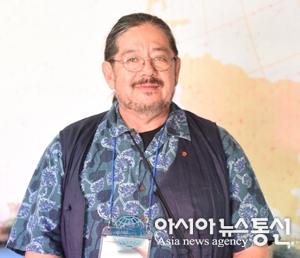 |
| 미국인 도예가 리 러브(Lee Love)씨.(사진제공=문경시청) |
문경전통찻사발축제 국제교류전에 참가한 미국 도예가 리 러브씨(Lee Love․61․미네소타 미니애폴리스)는 지난해 이 축제에 참가했다가 유태근 문경대 도자기공예과 교수에게 통일의 염원을 담은 도자 항아리 조각 작품을 선물받았다.
독실한 불교신자인 러브씨는 "집 안 불상 앞에 이 도자기 작품을 놓고 지금까지 매일 한국의 통일과 평화를 기원했다"고 밝혔다.
그는 또 "아버지가 한국전쟁에 참가했다가 일본에 머물면서 결혼을 하는 등 한국과 인연이 깊고 한국을 사랑하기 때문"이라고 덧붙였다.
지난해 전통찻사발축제에 다녀간 러브씨는 미국의 교포사회 소식지에 문경의 찻사발과 축제에 대한 이야기를 사진을 곁들여 자세히 소개하기도 했다.
25년째 도예의 길을 걷고 있는 그는 문경전통찻사발축제에 5년째 참가하면서 전통발물레도 제법 능숙하게 다루는 등 한국과 문경의 문화에 푹 빠졌다.
http://www.systranet.com translation:
Mungyong traditional chasbal ceramic art of bowlfestival and topic 'love (Lee Love)' input view:2015-05- 17: 22 Asia news agency = Kim Cheol-hee journalist American ceramic art love(Lee Love). (Photograph offer = Mungyong city hall)
“I intended with unification of Korea peacefor everyday.” Mungyong tradition chasabal
bowlfestival international interchange former theAmerican ceramic art which participated love(Lee Love 61 Minnesota Minneapolis) last yearparticipated to a festival gave a gift the catheterjar statue which put in the desire of unificationto Yu Tae-keun Mun Kyung-dae ceramic warei ndustrial art and professor. The love which is a sincere Buddhist “inside the house until noweveryday unification of Korea and prayed peace" disclosed this ceramic ware work before theBuddhist image over. He also “the father participated in a Korean War in Japan to stay,Korea and the karma which get married deep love Korea, because added ". Last year tradition chasabal the love which dropped
in to abowl festival in the overseas Koreans societynewsletter of the United States chas about thebowl and festival of Mungyong talk added the photo, introduced
fully. For 25 years he who walks the road of ceramic art Mungyong tradition chas participates
in a bowl festival for 5 years and also the traditional departurespinning wheel division skillfully,
fell thoroughly in Love with culture of Korea which treats and Mungyong.
Sunday, March 8, 2015
Dawan, Chawan, Chassabal: Connecting The Kizaemon Ido With the Potter
Another great article by Arthur Park on the Kizaemon Chasabal. Follow link below.
Dawan, Chawan, Chassabal: Connecting The Kizaemon Ido With the Potter
Dawan, Chawan, Chassabal: Connecting The Kizaemon Ido With the Potter
Thursday, February 5, 2015
Workshop in Mashiko, Japan July 2006
I a far away place, a long time ago.....

Please see Swanica's page here: http://swanceramics.blogspot.com/2006_07_01_archive.html
Images and tex from her blog below:
Swanica explores Japan
THURSDAY, JULY 13, 2006

Yesterday, I got the news that my "Horsehair Vase" was accepted in "The 6th Mashiko International Ceramics Competition 2006 of Japan". And the piece received a Judges' Special award, selected by the artcritic Rupert Faulkner. The prize winning works will be displayed at the Mashiko Museum of Ceramic Art from October 8 to December 10, 2006 in Japan.
Mashiko is an important potter’s village, made known by Hamada Shoji, the legendary pioneer of Japan’s pottery folk art movement. Mashiko represents the essence of the old Japan and a unique reservoir of local clay and hills suitable for the "nobori-gama" kilns. Hamada was convinced that outstanding craftsmanship flows from the natural environment. His vision was about fusing nature's grace and beauty with pottery's functional forms. He has a career-long devotion to the use of the delicate clay indigenous to Mashiko and was honored to be a "National Living Treasure".
My website: www.swanceramics.com
posted by Swanica explores Japan @ 1:07 AM 5 comments
WEDNESDAY, JULY 12, 2006
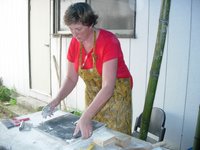
My first ANAGAMA firing in Lee Love's kiln.
First, we clean the shelves from the former firing, so the shelves will be even and nice.
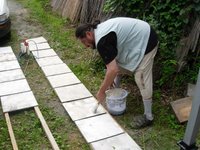
Lee paints the shelves with kiln wash, so, when accidents happen, and pots stick, it will be easier to take of the shelf.
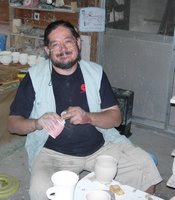 Then we glazed our pots.
Then we glazed our pots.Lee smiles relaxed and has everything under control!
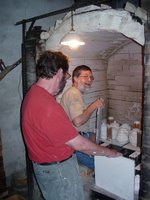
Jim and Hank fill the anagama. The two stoke holes are in the front. The fire goes through the flues and the flames shoot up in the back where the fire is the hottest.
 Jim and Adriaan, my husband, sawing the waste wood for the fire in smaller pieces.
Jim and Adriaan, my husband, sawing the waste wood for the fire in smaller pieces.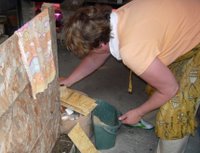 Weighing the wood, so that, every time you put wood in, the amount is the same: 2 Kg or 1.5Kg. First, every 10-15-20 minutes, but slowly building up to every 2-3 minutes till cone 13. This is around 2410 F or 1320 C.
Weighing the wood, so that, every time you put wood in, the amount is the same: 2 Kg or 1.5Kg. First, every 10-15-20 minutes, but slowly building up to every 2-3 minutes till cone 13. This is around 2410 F or 1320 C.
You have to stoke when no flames are shooting out anymore from the peephole.
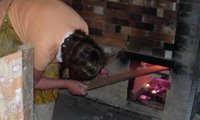
Stoking the anagama.
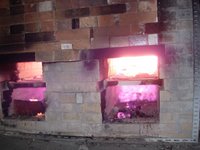
The stoke holes. By looking in the holes you can tell that the fire is already quite hot.
Unfortunately, we had to leave the next day. The kiln had to cool for several days.
I'll show you my results in one of my next blogs.
Hank and Jim traveled with me and Adriaan back to Kamakura, where they stayed for 2 nights.
We still has some other interesting visits.
We had a fabulous meeting with Yoshihiro Takishita at his home high up on Genji-yama (mountain) of Kamakura. He is an architect and antique collector/dealer. He moved and restored a gashi-type of farmhouse (snow country) and we got a tour from ground to attic and he showed us his screen collection dating from the Muromachi period. (The era when members of the Ashikaga family occupied the position of shogun is known as the Muromachi period, named after the district in Kyoto where their headquarters was located; 1392-1573).
He is the architect responsible for the restoration of the Yanagi home across the street from the Mingei-kan in Tokyo.
Next day, we went to see Robert Yellin, who lives in Mishima.
Robert Yellin has lived in Japan since 1984. His passion and deep interest in Japanese pottery has led him from collector to columnist and web host/dealer. He is an very knowledgeable and interesting collector and he very generously spent the afternoon showing us and talking about every pot in his office and gallery.
In 2 days, I will go back to the US for 3 1/2 weeks and see my youngest and oldest boys, do a lot of administration and financing and try to throw and fire lots of pots for future shows and "omiyage" (gift giving) in Japan.
posted by Swanica explores Japan @ 1:12 AM 1 comments
TUESDAY, JULY 11, 2006
 Of course we also visited Lee's workshop and anagama in which we did a firing.
Of course we also visited Lee's workshop and anagama in which we did a firing.Lee Love is the organizer of this Mashiko gathering workshop in visiting a lot of prominent Mashiko potters.
He did a wonderful job and I think we were all able to see some divinity in the masters of Mashiko and nature around us and to find some of it in ourselves.
This is Lee's "Ikuru" ("To Live"!) anagama (one chamber wood fire kiln).
The kiln is a modern, high efficient, woodkiln using waste wood for fuel, which is friendly to the environment.
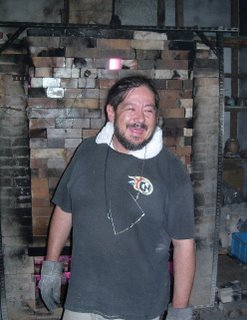 Lee makes functional pottery in an effort to preserve local culture in our modern throw-away society. His main goal is to inspire other people to make their own creative work. Human beings have always worked with their hands. "We are creators", he says. "We need both creativity and Nature to be healthy and whole human beings. Making and using handmade pottery is one way to bring nature and culture together in human life".
Lee makes functional pottery in an effort to preserve local culture in our modern throw-away society. His main goal is to inspire other people to make their own creative work. Human beings have always worked with their hands. "We are creators", he says. "We need both creativity and Nature to be healthy and whole human beings. Making and using handmade pottery is one way to bring nature and culture together in human life".Lee stokes the anagama.
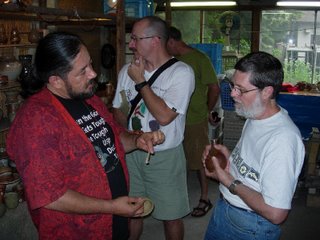 He was an apprentice for Shimaoka Tatsuzo from 2000-2003. Then he established his kiln and studio in Mashiko. He studies the cycles of nature, farming and their relationship to traditional pottery making.
He was an apprentice for Shimaoka Tatsuzo from 2000-2003. Then he established his kiln and studio in Mashiko. He studies the cycles of nature, farming and their relationship to traditional pottery making.Lee talks to Jim Laub, while Mike Martino looks at Lee's display.

Lee shows the rope rolling inlay.

This is the wood fired result "guinomi".

Display of Lee's work.
posted by Swanica explores Japan @ 6:31 PM 0 comments
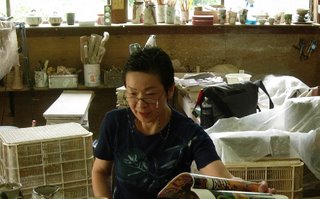
Yochiko-san works in her studio by herself.
She was an apprentice "deshi" from another quite well-known potter from Mashiko: Takauchi Shugo.
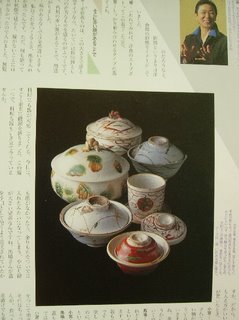
Her work is beautiful: white slip with on top an elegant free design.
 She also makes "Oribe" ware with this special green glaze.
She also makes "Oribe" ware with this special green glaze.Oribe ware is a high-fired ware that originated around 1600. This ceramic style is named after tea master and warrior Furuta Oribe (1545-1615). General features include a dark green copper glaze, white slip, underglaze brush work, and use of clear glaze.
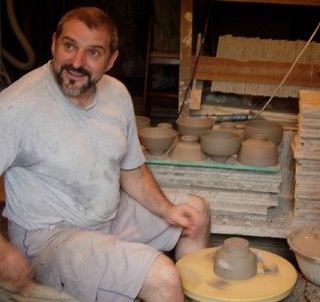 Euan Craig comes from Australia and was an apprentice for Shimaoka for quite some years, before establishing his own kiln in Mashiko.
Euan Craig comes from Australia and was an apprentice for Shimaoka for quite some years, before establishing his own kiln in Mashiko.Now, he lives in Ichikai, in the country. We had a beautiful drive to his house, where he lives with his family and offered us a cafe latte!!!
He has developed a variety of innovations, currently concentrating on creating wood fired porcelaineous stoneware with natural ash glazing. The brightness of his fired finish and above all his concentration on ceramics for food, his stance in pursuit of the beauty of function, is superb.

He showed us how he trimmed and used his chattering tool for his distinguished marks on his ceramic wares.
http://www.d1.dion.ne.jp/~euan/sub4.htm
posted by Swanica explores Japan @ 6:25 PM 0 comments

One morning, we bought a "bento box" lunch and drove to the Saimyoji temple, way up a hill.
Hank, Lee, Jim and Craig.

Saimyoji Temple, also known Tokka-san Fumin-in, is a temple of the Busan Shingon School. Its main revered figure is the Eleven-Faced Kanon Bosatsu who achieved perfect freedom from egoism to arouse great compassion.
It was built in the 9th year of the Tempyo Era (A.D.737) by the great priest Gyoki Bosatsu with the backing Ki Arimaro, (Ki being the old surname of the Mashiko family).
It was dedicated in 739. At its height of influence in 782 it had twelve places of residence for monks.
In 1127, all the buildings were destroyed by fire, rebuilt in 1178, and destroyed again in 1351. The main hall was rebuilt in 1394 and restored in 1701.
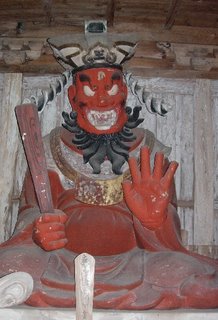
In 1714, the hall, which houses
the "Laughing Emma" (Emma-do) and carved out of wood,
was built. (8 feet tall).

You will meet this guy in hell.
(6 feet tall). Also, carved out of wood.
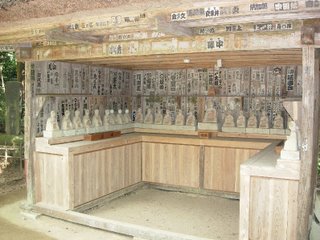
Some praying monk statues
in a small hall.
posted by Swanica explores Japan @ 5:45 PM 0 comments
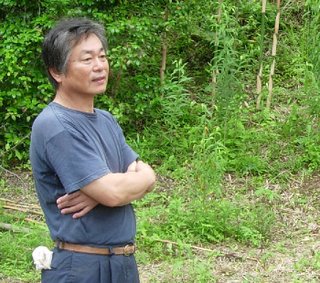
We also visited Kamiya Shouichi.
He lives also in Mashiko and is a 5 minute
walk away from Furiki-san, the tougei place we stayed at.
He is a former apprentice "deshi" of Shimaoka and worked with David McDonald.
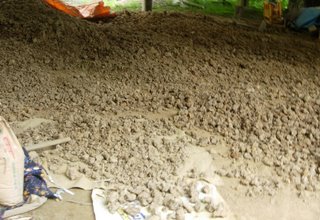 Shimaoko had told him, when he was going to build his own kiln, to find a place where was a clay deposit. It was across from his house and workshop.
Shimaoko had told him, when he was going to build his own kiln, to find a place where was a clay deposit. It was across from his house and workshop.He showed us the place.
Here clay is dug out and is drying.

After processing it, it is put in plaster molds and dried to a wedging state.

His ware from the gas kiln is very distinctive and beautiful. I bought a small cup "guinomi" from his showroom.
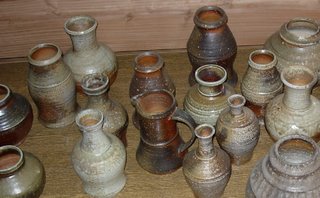
He fires his wood fire combination anagama-noborigama once a year. His forms are very playful.
posted by Swanica explores Japan @ 5:17 PM 0 comments
MONDAY, JULY 10, 2006
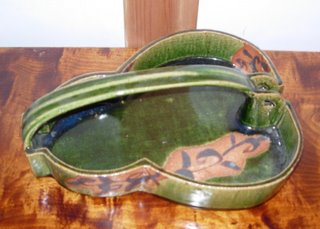 Matsuzaki Ken is born in 1950 in Tokyo and graduated from the Fine Arts Ceramics Department at Tamegawa University in 1972. Directly after that, he apprenticed for five years with Shimaoka Tatsuzo. He established his own kiln, "YuShin (Playful Spirit)" in 1978.
Matsuzaki Ken is born in 1950 in Tokyo and graduated from the Fine Arts Ceramics Department at Tamegawa University in 1972. Directly after that, he apprenticed for five years with Shimaoka Tatsuzo. He established his own kiln, "YuShin (Playful Spirit)" in 1978.Matsuzaki is challenging his craft with new forms and styles and won't become complacent about his work whatsoever. That always makes his work refreshing. He doesn't rehash his succesful styles over and over again. You can say for him that for any true artist the discovery of what lies within is as important as what is created. So, he has been busy creating, changing, daring, and stumbling and ultimately standing proud next to his wide range of works.
His homepage shows dozens of pieces: www.yuushin-gama.com and dare to brows. It is only Japanese.
We had a wonderful time visiting with him and his wife. We saw his special anagama kiln, which he can stoke from two sides.

Two stoke sided
Anagama(one chamber).
Two years ago, he built a new noborigama for his gold and purple "Shino", special whitish glaze. He showed us his workshop

Matsuzaki Ken with
some of his glazed
work.
and showroom, where we had some nice cold green tea, because, it was very muggy and hot. Mike and David again helped a lot with translating the Japanese.
They also talk some English. Hank knew him from the Pucker Gallery in Boston, where he had an exposition. He has some beautiful wood fired pieces and gold shino bowls. He also gave us a catalogue and on our way out even a small "Guinomo" (cup). Beautiful!
posted by Swanica explores Japan @ 6:17 AM 0 comments
 Shimaoka Tatsuzo is born in 1919 in Tokyo.
Shimaoka Tatsuzo is born in 1919 in Tokyo.When Shimaoka was a teenager , wondering what to do when he grew up, he visited the Nihon Mingeikan (Japan Folk Crafts Museum in Tokyo) in 1938. There he discovered the beauty of Mingei advocated by Yanagi Soetsu (1889-1961). Shimaoka had found what he wanted to become and met the most passionate advocates of Yanagi's Mingei Movement: Hamada Shoji, Kawai Kanjiro and Bernard Leach.
 Shimaoka began making pottery in 1939 as a student at the Tokyo Institue of Technology's Department of Ceramics. Shimaoka joined Hamada's workshop as an appentice after graduation and four years later, built his own, independent kiln adjacent to his teacher's in Mashiko.
Shimaoka began making pottery in 1939 as a student at the Tokyo Institue of Technology's Department of Ceramics. Shimaoka joined Hamada's workshop as an appentice after graduation and four years later, built his own, independent kiln adjacent to his teacher's in Mashiko.Shimaoka developed his own personal style. He was designated a "Living National Treasure" by the Japanese government in 1996 for developeng a pottery technique where white slip is applied to rope impressions made in the surface of the pot when it is still wet: something he calls "Jomon Zogan".
 Shimaoka-san himself gave us a tour despite his old age and showed us his kilns, the workshops with throwing, decorating and glazing areas. David apprenticed with him for 2 years 27 years ago and Lee in 2000 for 3 years.
Shimaoka-san himself gave us a tour despite his old age and showed us his kilns, the workshops with throwing, decorating and glazing areas. David apprenticed with him for 2 years 27 years ago and Lee in 2000 for 3 years.Shimaoka-san talking to his "deshi".

Putting slip on a rope impressed vessel.

Scraping off the hardened white slip.

Platters drying in the sun.

We also went in his showroom. You always take your shoes off and walk carefully around. He was preparing for a show. His work is beautiful, but of course quite expensive.
We had tea in his house and we drank from his cups and had a nice talk. He knew quite some english, understood more then he could talk. Mike and David did most of the talking because of their Japanese language skills. We got a catalogue from him when we left and he joked, when he looked at it, that it was old work and that it was time to make some new designs. Good for him!
posted by Swanica explores Japan @ 3:02 AM 0 comments
Hamada Shinsaku is Hamada's Shoji's second son. He is born in 1929 in Tokyo.

He studied Art and Craft at Waseda University before becoming an apprentice with his father at his pottery at Mashiko. In 1963 he came to the Leach potery with Shoji before traveling for a year visiting the USA as an assistant to him for his lecture on ceramic arts. At the Nihonbashi Mitsukoshi Store art Gallery in Tokyo in 1970 he held his first one-man exhibition. Since then he travelled extensively and held many exhibitions and Tougei(ceramic art) demonstrations.
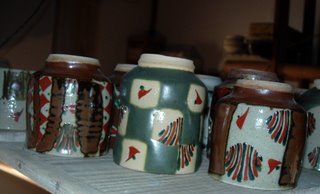
Glazed cups.
He lives next to the Reference Museum of which he is director. He showed us around his compound and saw his workshops and beautiful noborigama(climbing kiln), which he fires in spring and autumn. Summer and winter are either too hot or too cold.

The Noborigama.
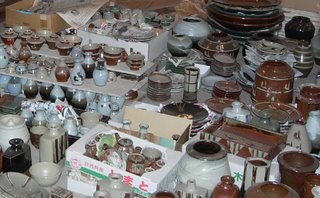
Ware ready to
be sold.
Assistants, "deshi", were glazing pots when we arrived. We received a book with pictures of his work in honor of his 77th birthday.
His son, Hamada Tomoo, is well known too.
posted by Swanica explores Japan @ 1:27 AM 0 comments
SUNDAY, JULY 09, 2006
 On Sunday, we visited Gerd Knapper: a potter, ceramic artist, sculpture and person of lots of other trades: painter and decorator, restorer, art metal workshop assistant, sailor, photographer and architect.
On Sunday, we visited Gerd Knapper: a potter, ceramic artist, sculpture and person of lots of other trades: painter and decorator, restorer, art metal workshop assistant, sailor, photographer and architect.David, Lee, Hank, Craig, Jean (Lee's wife), Jim, Swanica, Mike and Gerd Knapper.
 We drove through the wonderful Tochigi prefecture country side with plenty of rice fields and beautiful flowers (red puppies, irisses) as we arrived at his Tarosaka studios and fabulous and world famous Japanese manor in Daigo-machi(town) with dormor windows and reed thatched roof. It was built about 170 years ago and Gerd Knapper restored and redesigned it in 1976.
We drove through the wonderful Tochigi prefecture country side with plenty of rice fields and beautiful flowers (red puppies, irisses) as we arrived at his Tarosaka studios and fabulous and world famous Japanese manor in Daigo-machi(town) with dormor windows and reed thatched roof. It was built about 170 years ago and Gerd Knapper restored and redesigned it in 1976.
We were greeted by him, his wife and oldest daughter. He is a very interesting, generous, hospitable and friendly man and offered us refreshments. He took us to the "Fukuroda no taki" (waterfalls) and gave us a delicious lunch with view of the falls.
On our return, he showed us his noborigama (climbing kiln), other kilns and workshops. In the fall, he will open a gallery in one of his barns.
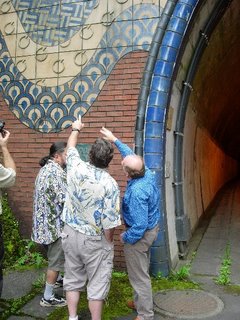
Gerd Knapper's prides include his family, house ceramics, sculptures and commissions. His ceramics are scattered in museums and houses all over the world.
He has been living in Mashiko for 6 years as the first foreigner potter before establishing himself in Daigo for 31 years by building his own kiln. He has been strongly influenced by the country and in turn strongly influences pottery in Japan. He has succeeded in combining the Japanese style with the technical expertise brought to Japan from his native Germany.
Knapper has done what no western ceramist had accomplished before him. He not only won both the prestigious "Minister of Education Award" and the no less prestigious "Prime Minister's Award", but he followed his distinctly individual vision and still was enormously successful with the Japanese public.

Knapper's art reflects his affinity for nature. Shells and flowers are among his recurring forms. He demonstrates respect for the achievements of Japanese potters, yet he is only Knapper the artist, who cannot be claimed by a country or style.

posted by Swanica explores Japan @ 9:33 PM 0 comments
Subscribe to:
Posts (Atom)

